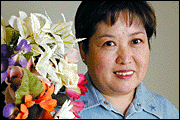


In The Garden
![]()
Friday, November 19, 1999

Courtesy of Stephen Ferreira
The king protea, above, is a true protea.
PROTEA farmer Noelani Whittington has a free-spirited gray mare, a wedding gift from her husband, to thank for her six-acre farm on the Big Island. Envisioning protea
in every yard"That little horse, she never stayed home at night," says the tourism executive turned farmer. "She and her little boyfriend ... They would go all over the place. They'd start off visiting the neighbor's tennis court, then they'd go galloping down the highway. We HAD to buy the farm -- for the horse."
The Polish Arabian was sold eventually, and Whittington was left with six acres of grass and no plan for the farm.
"Then my mother brought me a protea plant she bought in Hilo. I stuck it in the ground, and it grew and it grew and it grew."
Several months later, Whittington harvested 16 blossoms. She drove them down to Hilo and sold them all for 25 cents, and that was the first chapter of her life as president of Noelani Farms in Holualoa more than 15 years ago.
"Can you imagine, a quarter? And, I was so happy to get that quarter. I earned it from something I grew with my own hands. I was thrilled. Now, of course, nothing on my farm sells for a quarter. But you can still get a good deal."
Sale of protea flowers, wreaths, and arrangements by neighbor island protea growers. Also, protea wreath demonstrations. PROTEA WREATH FESTIVAL
When: 10 a.m. to 9 p.m. today and tomorrow, 10 a.m. to 4 p.m. Sunday
Where: Windward Mall, second floor, across from The Gap
Cost: Free
Call: 235-1143
Whittington and other protea farmers from Maui and the Big Island will be selling their products directly to the public today and through the weekend during the Protea Wreath Festival at Windward Mall. The farmers will be selling cut flowers, wreaths and arrangements as well as demonstrating wreath making.
Winter is the peak blooming season for the protea, whose origins can be traced back 300 million years. It is found in parts of South Africa and Australia, and grown in many parts of the world, including Hawaii, as a commercial crop for the sturdy blossoms.
Protea, pronounced "pro-tee-ah" with accent on the first syllable, is a challenge for the backyard grower in Hawaii where it is mostly warm and moist. The plant does well with cool temperatures, dry air and well-draining, often poor soil.
That means protea is seldom grown outside of commercial farms on the neighbor islands. But experts say the plant can thrive in Pupukea, Wahiawa and other higher elevation areas on Oahu.
"Proteas have to have cool night temperatures, but it can't be moist because they are susceptible to diseases on the foliage," says Ken Leonhardt, horticulturist with the Protea Research Project at the University of Hawai'i.
He has been trying to develop hybrids that are adaptable to the islands' tropical climate and plans to begin an experimental planting on Oahu soon.

"It's a matter of finding hybrids that are tolerant of our conditions. I don't see why it can't find popularity as a landscape plant," says Leonhardt, who thinks the right hybrids can be identified in about two more years.Researchers have been trying to breed better hybrids at the university's Maui County Agricultural Research Center since protea was introduced to Hawaii in the mid 1960s. Over the years, the Kula experiment station has introduced a number of hybrids that have become known around the world as from Hawaii, says Stephen Ferreira, a university plant pathologist and protea expert.
The hybrids are all pincushions, which are round flowers with protruding thin bracts resembling an overstuffed pincushion. Some well-known Hawaii hybrid blossoms include "Hawaiian Gold" and "Kathryn," both bright canary yellow; "Rachel" and "Hawaiian Sunbeam," two bright reds.
The Kula experiment station, funded by state and federal governments, distributes new hybrid cuttings twice a year through the Protea Growers Association of Hawaii, a nonprofit organization of commercial protea farmers. The farmers pay 50 cents a cutting to the association, and the money helps the Kula facility. The hybrids are not available to the public.
Commercial protea farms numbered 50 statewide at one time but have dwindled to 27, says Whittington, a past president of the growers association. Almost all the farms are family-owned and family-run operations on land ranging from about 1 to 10 acres.
PROTEA FACTS
The protea is named after Proteus, the Greek sea god who can change his form at will to avoid capture. The protea family, Proteaceae, has more than 1,400 species of evergreen trees, shrubs and herbs, including the macadamia tree. About 100 varieties are grown in Hawaii. There are four genera in the family:
True protea, such as the king, queen and mink proteas, known for large, artichoke-like blossoms with feathery bracts.
Banksia, which produces large blossoms resembling fluffy bottle brushes.
Leucadendron, mostly cultivated for its foliage.
Leucospermum, which produces pincushion blossoms.
The blossom of a true protea is not a single flower, but a tight cluster of many tiny flowers held within brightly colored bracts. The blossom is a long-lasting cut flower and dries well for wreaths.
Back-yard growers likely will have more success with banksia and pincushions, which are more tolerant of warmer temperatures, experts say.
Protea plants can be difficult to find, but Star Garden Supply often carries a small collection.
Gardening Calendar in Do It Electric!
Send queries along with name and phone number to:
In The Garden, Honolulu Star-Bulletin, P.O. Box 3080, Honolulu 96802.
Or send e-mail to features@starbulletin.com.
Please be sure to include a phone number.In The Garden by Suzanne Tswei is a regular Friday feature of the
Honolulu Star-Bulletin. © All rights reserved.